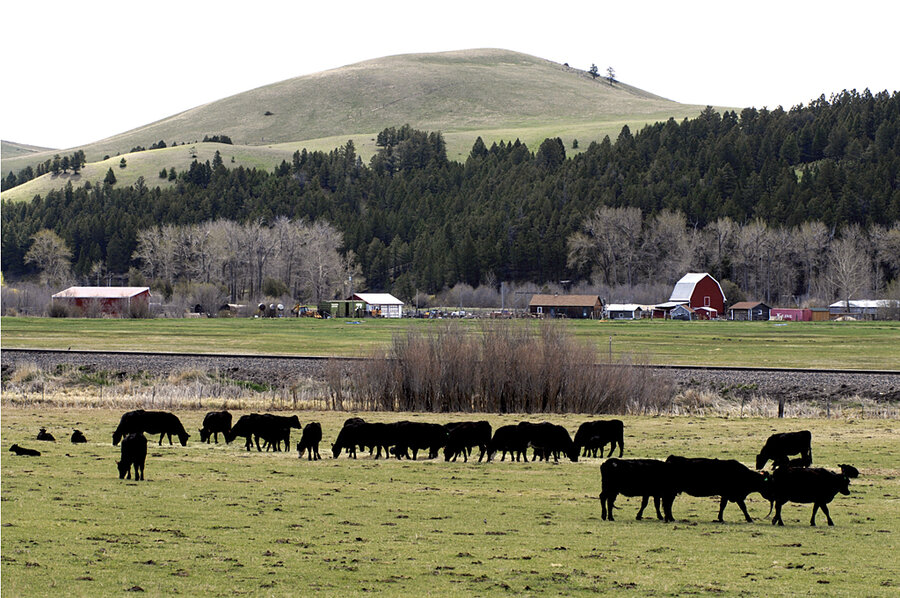Saving US grasslands: a bid to turn back the clock on desertification
Loading...
Three years ago, the grasslands of Mike Livingston's Colorado ranch were drying out.
In the hills north of Hell Creek "you could see the sand between the sagebrush from a mile away. Whenever we got hard south winds, you could see the sand blowing."
For a rancher whose livelihood depended on those diminishing grasslands, it was an oncoming economic and ecological disaster in slow motion. For the wider world, it was one more example of how prairies and savannas from Alberta to Africa are inexorably being swallowed by growing global wastelands.
Desertification caused by climate change and human activity now threatens the livelihoods of more than 1 billion people worldwide, according to the United Nations. Globally, 52 percent of land used to grow food has been affected either moderately or severely.
But on that patch of Colorado prairie, something different happened: The grass came back. Today, "the grass has covered the sand," says Mr. Livingston. A dozen or more sandy, wind-blown basins have become lush and green.
What made the difference was a simple idea with tremendous global consequences. In short, Livingston tried to turn the clock back on his land by moving his cattle around the land in a way that mimics the movement of buffalo centuries before. The idea is called Holistic Management, and users say it is a powerful tool to undo the damage that humans have inflicted on grasslands worldwide.
"Human beings are a desert-making species," says Luc Gnacadja, executive secretary of the UN Convention to Combat Desertification. But Holistic Management "is a game changer."
Developed by an African rancher, Allan Savory, over several decades and established on a Zimbabwe ranch in 1992, the Holistic Management model is now making inroads in the United States. Backers say it has the potential to revitalize broad swaths of the American West. To do so, however, would require a change in decades-old ranching practices, which means that the revolution, for now, is starting small.
The idea behind Holistic Management is that grasslands were healthier before modern ranching began. The reason: As huge herds of herbivores roamed the landscape, they revitalized it, nibbling plants to stimulate root growth, trampling the ground in ways that broke apart caked earth to allow seeds to germinate and water to seep in, and fertilizing the ground with their dung.
As grasslands have been fenced off, however, herbivores have become sedentary, and these processes have been impeded. Holistic Management (HM) involves using livestock as though they were the grazing mammals of old, herding them across property according to a planned schedule. The approach is now being applied to more than 40 million acres around the world – about the size of the state of Wisconsin. In the US, interest has grown since Mr. Savory won the 2010 Buckminster Fuller Prize, which rewards "a strategy that has significant potential to solve humanity's most pressing problems," according to the website.
•Savory has met with Republican Reps. Paul Gosar of Arizona and Steve Pearce of New Mexico to discuss HM's potential to help revive more than a half million acres of Western lands devastated by forest fires.
•A US Department of Agriculture grant is paying for 90 women farmers in six Northeastern states to learn HM.
•A New Mexico-based consultancy specializing in HM is running workshops in Colorado, Nebraska, and Kansas to combat degradation of the Republican River watershed.
"In the US this is not fringe stuff anymore," says Jody Butterfield, Savory's wife and colleague. "The fires are getting worse; floods are getting worse. When you show that you can do something to fix it, people want to know more."
At Twodot Dot Land and Livestock Co. near Harlowton, Mont., HM is paying dividends, says manager Zachary Jones. In a season of record-breaking floods, the Musselshell River saw 13 times its usual spring runoff. But while nearby ranches sustained huge losses – $20,000 diesel generators washed away, livestock drowned – Twodot's 24,000 acres remained unscathed. Because of Holistic Management, the land was healthier, which means it soaked up the water like a "larger sponge" – rather than letting it run off.
Beyond reclaiming grassland, HM excites environmentalists because healthier land absorbs more carbon from the atmosphere, helping to mitigate climate change.
"Carbon in the atmosphere is a pollutant, but in the soil is a nutrient, essential to keeping soil fertile and keeping water in the aquifers and watersheds," says the UN's Mr. Gnacadja. "Without a holistic process to keep carbon in the soil and out of the atmosphere, we will not be successful in dealing with global warming – or concerns over water, food security, and poverty."
But large-scale success in the US would mean an overthrow of the way ranchers have done their business since they arrived in the American West. The challenge is getting the word out and getting ranchers to change their way of thinking.
The 16,000 acres of Livingston Ranch are a testimonial, says the owner. "Today the wind is blowing around 60 miles per hour," says Livingston. "If it weren't for these management practices, it would be pretty ugly around here."





